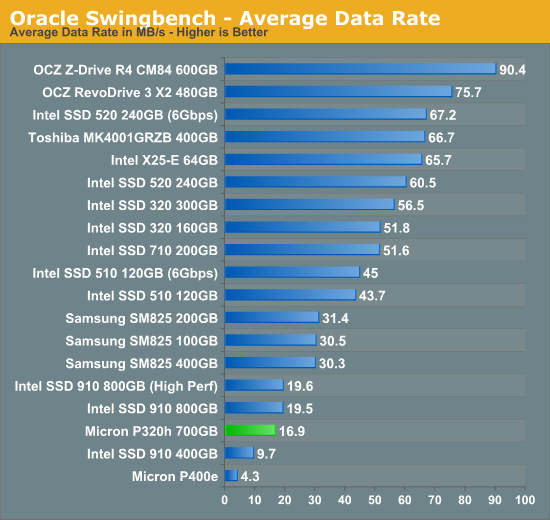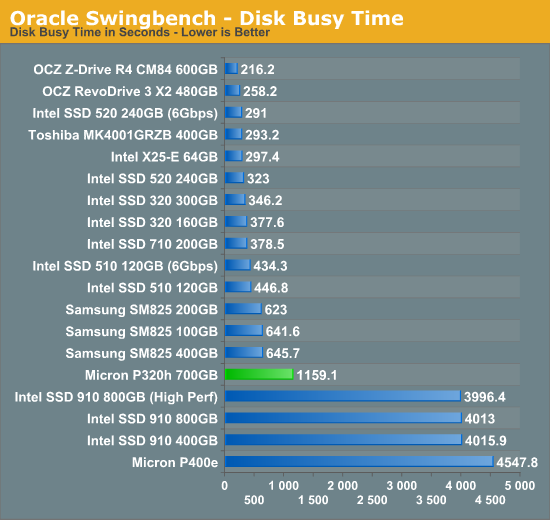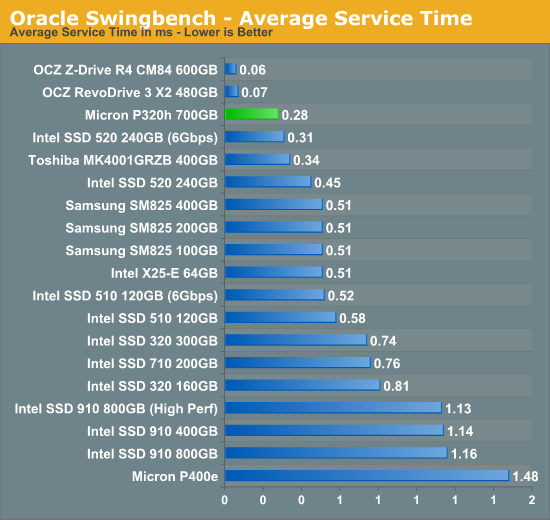Micron P320h PCIe SSD (700GB) Review
by Anand Lal Shimpi on October 15, 2012 3:00 AM ESTEnterprise Storage Bench - Oracle Swingbench
We begin with a popular benchmark from our server reviews: the Oracle Swingbench. This is a pretty typical OLTP workload that focuses on servers with a light to medium workload of 100 - 150 concurrent users. The database size is fairly small at 10GB, however the workload is absolutely brutal.
Swingbench consists of over 1.28 million read IOs and 3.55 million writes. The read/write GB ratio is nearly 1:1 (bigger reads than writes). Parallelism in this workload comes through aggregating IOs as 88% of the operations in this benchmark are 8KB or smaller. This test is actually something we use in our CPU reviews so its queue depth averages only 1.33. We will be following up with a version that features a much higher queue depth in the future.

Intel's SSD 910 didn't do well at all in our Oracle Swingbench test, mostly due to its inability to perform well at very small transfer sizes (512B). The P320h is no different here and is easily outperformed by standard 2.5" SATA SSDs (although Micron's P400e also does really poorly here). The results here just go to show how important it is that you understand your workload when picking an enterprise SSD.
Average service time is nice and low for the P320h, it's just we don't end up seeing a high throughput rate for the SSD.












57 Comments
View All Comments
zlyles - Wednesday, October 17, 2012 - link
Because it wasn't meant to be... it makes me laugh to see how many people think Micron, Intel, and OCZ are developing these PCI-e SSD's for the consumer market. This is an enterprise class drive, and as such is not meant to be a bootable drive unless you are booting VM's on a hypervisor.Cloakstar - Monday, October 15, 2012 - link
I get the impression these tests did not stress this drive.Compare the relationship between disk busy time and average QD for the test tp the other drives. The higher the QD, the lower the relative disk busy time compared to the competition.
-In IOMeter tests with QD32, no disk busy time is recorded, but the drive is in a solid lead for random noncompressible data throughtput.
-The poorest numbers for this drive happen at lowest QD.
-The highest listed QD for any test, here is 32.
-"Micron claims much higher sequential read/write numbers under Linux at 256 concurrent IOs."
apmon2 - Tuesday, October 16, 2012 - link
"I get the impression these tests did not stress this drive."Yes, that seems to be the case. thessdreview.com have what looks like a really nice review [1] including tests of a QD up to 512. There one can see that it achieves only about a 1/3 of its peak performance with a QD of 32. Not till a QD of 128 or even 256 does it achieve its full potential. Then however it seems to perform truly amazing, and is able to completely saturate the 8x PCIe 2.1 bus with 4k random reads! It supposedly can sustain 3.3GB/s of 4kb random reads.
Even at small 512B read requests it can, according to them, still achieve on the order of 600Mb/s, achieving well in access of 1.5 million IOps. Even then the limiting factor was the CPU, not the device, despite using a core i7 that was overclocked to 4.9 GHz.
So if those numbers are true, Anand didn't even come close to stressing this SSD to its limit (or intended purpose).
[1] http://thessdreview.com/our-reviews/micron-p320h-h...
bthanos - Monday, October 15, 2012 - link
Hi Anand,Nice Article, however the Micron p320h is not a NVME interface drive. Its PCIe Gen 2 , AHCI.
Jaybus - Tuesday, October 16, 2012 - link
As stated in the article, the drive is using IDT's 32-channel PCIe gen 3 x8 controller, but operating it in gen 2 mode. Since x8 gen 2 is sufficiently faster than the drive is capable of, it is a good choice, as it allows compatibility for use in systems without gen 3 slots. IDT claims full compliance with the NVM Express standard. See http://www.idt.com/products/interface-connectivity... for controller specs.Looks like a NVM Express drive to me. Why would you say it is not?
bthanos - Tuesday, October 16, 2012 - link
Because the IDT controllers released at Flash Memory Summit are new SOCs, the Micron p320h drive is using a previous jointly developed SOC which is not NVME. See comment from Anand..colonelpepper - Monday, October 15, 2012 - link
On the issue of durability or whatever you want to call it..."50 petabytes of writes" is totally meaningless marketing intellect abuse.
It only takes on a meaning if you were to fill up the entire drive at once and then erase it and then write to the entire volume again etc until you reached 50 petabytes of writes.
Show me a hard drive that is ever used like that and I'll donate the pot of gold I've got stashed out back to your favorite charity.
DataC - Tuesday, October 16, 2012 - link
Colonel Pepper, at Micron we spec TBW or total bytes written, but it’s closely related to another standard you’ll see in the enterprise industry, “X drive fills per day for 5 years.” The two specs are simply different ways to express the same number. The spec tracks the amount of bytes you can write to the SSD before the NAND exceeds its wear life and reverts to a write-protect (read only) mode. It includes any and every write ever made to the drive, not just the full drive fills and erases you’ve described.rrohbeck - Monday, October 15, 2012 - link
What I don't understand though is why SSD controllers don't have PHYs that can talk PCIe as well as SATA/SAS. Then manufacturers could leverage the high volume/high performance SATA/SAS designs for PCIe too. The firmware would probably be even simpler.DanNeely - Monday, October 15, 2012 - link
Because it would be adding additional complexity, die size, and cost, to mass produced consumer parts with very thin margins. All of which are good ways to go out of business.